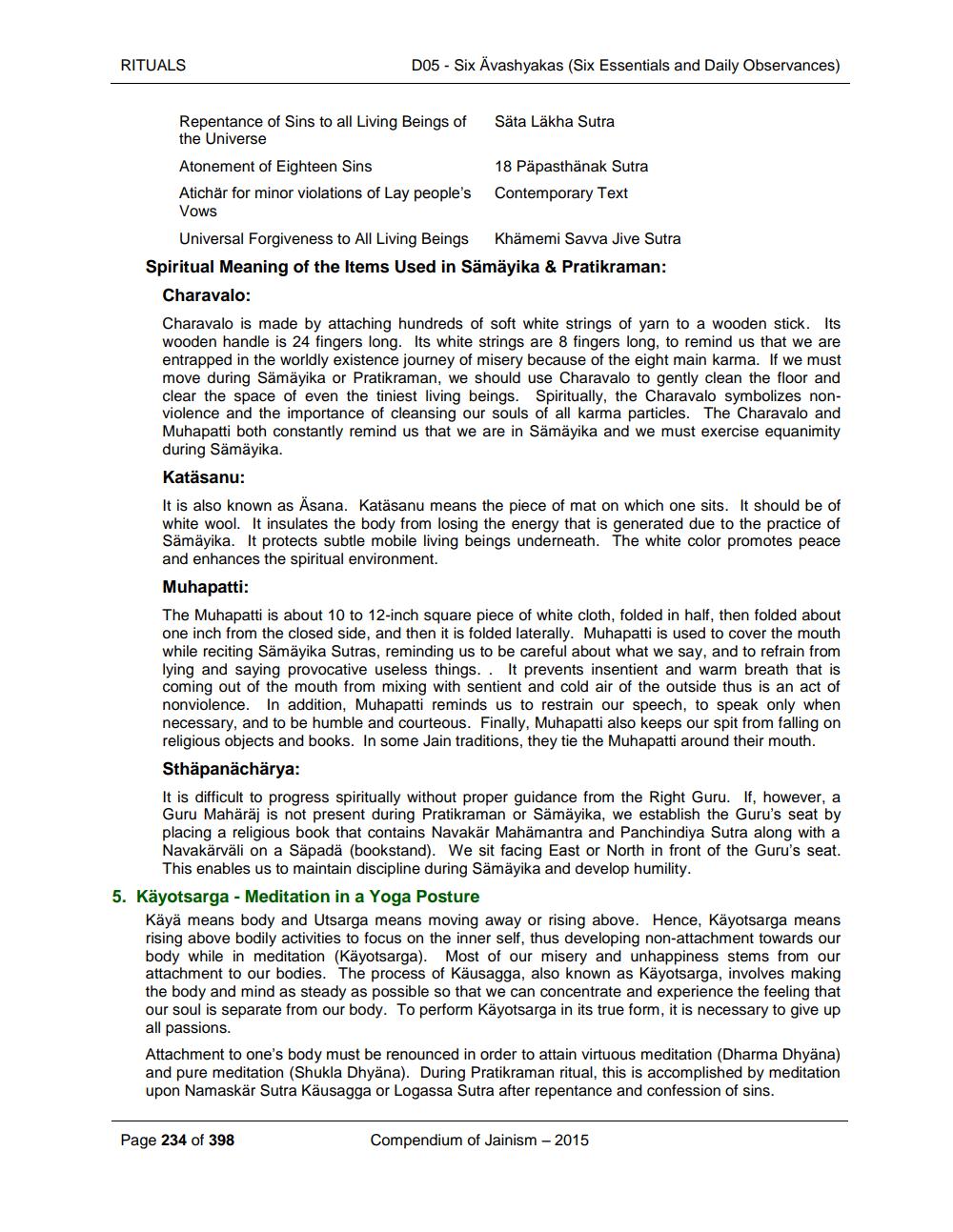________________
RITUALS
DO5 - Six Ävashyakas (Six Essentials and Daily Observances)
Repentance of Sins to all Living Beings of Säta Läkha Sutra the Universe Atonement of Eighteen Sins
18 Päpasthänak Sutra Atichär for minor violations of Lay people's Contemporary Text Vows
Universal Forgiveness to All Living Beings Khämemi Savva Jive Sutra Spiritual Meaning of the Items Used in Sämäyika & Pratikraman:
Charavalo: Charavalo is made by attaching hundreds of soft white strings of yarn to a wooden stick. Its wooden handle is 24 fingers long. Its white strings are 8 fingers long, to remind us that we are entrapped in the worldly existence journey of misery because of the eight main karma. If we must move during Sämäyika or Pratikraman, we should use Charavalo to gently clean the floor and clear the space of even the tiniest living beings. Spiritually, the Charavalo symbolizes nonviolence and the importance of cleansing our souls of all karma particles. The Charavalo and Muhapatti both constantly remind us that we are in Sämäyika and we must exercise equanimity during Sämäyika. Katäsanu: It is also known as Äsana. Katäsanu means the piece of mat on which one sits. It should be of white wool. It insulates the body from losing the energy that is generated due to the practice of Sämäyika. It protects subtle mobile living beings underneath. The white color promotes peace and enhances the spiritual environment. Muhapatti: The Muhapatti is about 10 to 12-inch square piece of white cloth, folded in half, then folded about one inch from the closed side, and then it is folded laterally. Muhapatti is used to cover the mouth while reciting Sämäyika Sutras, reminding us to be careful about what we say, and to refrain from lying and saying provocative useless things. . It prevents insentient and warm breath that is coming out of the mouth from mixing with sentient and cold air of the outside thus is an act of nonviolence. In addition, Muhapatti reminds us to restrain our speech, to speak only when necessary, and to be humble and courteous. Finally, Muhapatti also keeps our spit from falling on religious objects and books. In some Jain traditions, they tie the Muhapatti around their mouth. Sthäpanächärya: It is difficult to progress spiritually without proper guidance from the Right Guru. If, however, a Guru Mahäräj is not present during Pratikraman or Sämäyika, we establish the Guru's seat by placing a religious book that contains Navakär Mahämantra and Panchindiya Sutra along with a Navakärväli on a Säpada (bookstand). We sit facing East or North in front of the Guru's seat.
This enables us to maintain discipline during Sämäyika and develop humility. 5. Käyotsarga - Meditation in a Yoga Posture
Käyä means body and Utsarga means moving away or rising above. Hence, Käyotsarga means rising above bodily activities to focus on the inner self, thus developing non-attachment towards our body while in meditation (Käyotsarga). Most of our misery and unhappiness stems from our attachment to our bodies. The process of Käusagga, also known as Käyotsarga, involves making the body and mind as steady as possible so that we can concentrate and experience the feeling that our soul is separate from our body. To perform Käyotsarga in its true form, it is necessary to give up all passions. Attachment to one's body must be renounced in order to attain virtuous meditation (Dharma Dhyana) and pure meditation (Shukla Dhyana). During Pratikraman ritual, this is accomplished by meditation upon Namaskär Sutra Käusagga or Logassa Sutra after repentance and confession of sins.
Page 234 of 398
Compendium of Jainism - 2015




